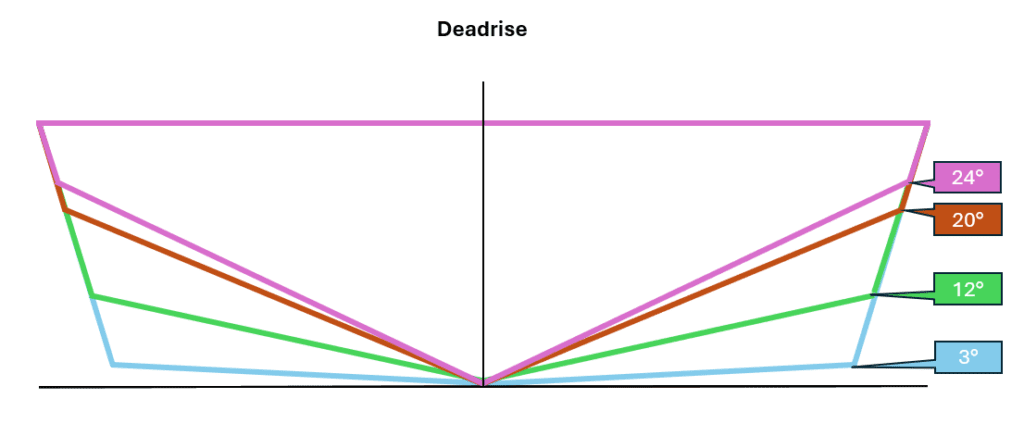Here is a basic introduction to the concept of deadrise. We will speak in generalities as there are always exceptions to the rules, but if you stick through to the end you’ll have a pretty good, high-level, grasp of deadrise and how it’ll affect your next boat or fishing trip. Enjoy.
Ramblin's
Back in grad school at the University of Florida, I helped chaperone a teen trip to the Florida Keys for Mini-Season. If you’re unfamiliar, Mini-Season is a magical two-day head start on Florida’s lobster season for recreational divers. I ended up captaining a 26′ walk-around boat with a cuddy cabin and an oversized 200hp Honda outboard. The new motor had been mounted on a bracket—secured with actual chains—to eye bolts through the transom. It didn’t inspire much confidence. The boat had a deep-vee hull and felt wildly unstable. At one point, someone spotted a shark and everyone rushed to one side. I truly thought we might capsize. I’ve never been happier to get a boat back on a trailer. That experience taught me a lot about how deadrise affects stability and horsepower requirements—topics we’ll explore below.
Intro: Deadrise 101

Shopping for the perfect fishing boat can feel like navigating a sea of technical jargon. One term that really matters: deadrise. It plays a big role in how a boat rides and performs. In this article, we’ll break down what deadrise is and why it matters. We’ll cover how it impacts different boats—from jon boats to offshore rigs, with flats and bay boats in between. You’ll also learn how deadrise affects things like draft, horsepower needs, and stability. With a better understanding, you’ll be more confident choosing the right boat for your needs
The Basics of Deadrise
Deadrise refers to the angle of a boat’s hull bottom in relation to a horizontal plane. It’s typically measured in degrees, with a higher degree indicating a steeper V-shape. Different boat types have varying deadrise angles, each tailored to provide optimal performance in specific environments. See our rudimentary illustration below. Each of the different colors represents a different degree of deadrise.

Jon Boats, Air Boats, Bateaus: Shallow Waters, Wide Appeal
These boats, generally renowned for their simplicity and versatility, are characterized by a flat bottom and low deadrise. With a minimal deadrise angle, usually around 0-6 degrees, jon boats, air boats, bateaus, and the locally famous North Carolina Harker’s Island Skiff are ideal for shallow waters, making them popular choices for fishing in creeks, inland bays, and calm rivers. The shallow draft allows for easy navigation through tight spaces, making these boats suitable for anglers seeking elusive fishing spots.
Flats Boats: Navigating Shallow Flats with Ease
Flats boats are designed for shallow-water fishing in saltwater environments. Their hulls typically feature a moderate deadrise, ranging from 6-18 degrees. This deadrise angle strikes a balance between stability and shallow-water performance, allowing anglers to navigate the flats with ease while still enjoying a smooth ride. Often, rounded chines helps to reduce slapping sounds coming from the sides of the hull. With anglers standing on poling and casting platforms, the center of gravity is raised and too much deadrise results in a tippy boat. It is a balance between shallow draft, a smooth ride, and quiet poling. The modern flats boat straddles the line of doing all of these things fairly well.
Bay Boats: Versatility in Coastal Waters
Bay boats are versatile, handling both inshore and nearshore waters with ease. Most have deadrise angles between 15 and 20 degrees, striking a balance between shallow-water access and offshore capability. They offer a stable fishing platform and can handle modest offshore runs. As engine technology advances, more bay boats now feature 300hp or even 400hp motors. There’s a clear trend toward bigger, faster boats. Higher deadrise gives a smoother offshore ride, but it comes at a cost—more horsepower, fuel, and budget. Bay boats used to stay in the 20-24 foot range. Now we’re seeing larger models push into the 28-foot class. This evolution has created a new category: the “Hybrid” bay boat, blending bay and offshore features.
Offshore Fishing Boats: Conquering the Open Sea
Offshore fishing boats demand a design that can handle the challenging conditions of open water. These high-performance vessels boast deep V-hulls with deadrise angles exceeding 20 degrees, often reaching 24 degrees or more. The steep deadrise provides excellent wave-cutting capabilities, ensuring a smoother ride in rough seas. Higher deadrise angles also contribute to increased stability at high speeds, a critical factor in offshore fishing. By their nature, they require multiple high-horsepower engines to push the deep-vee hull quickly. They tend to be prone to rocking violently in a cross-sea and we’ve seen the rise of catamarans like the Freeman and the use of gyroscopic stabilizers like the Seakeeper to counteract the rocking.
Conclusion & Shameless Plug
Understanding the impact of deadrise on boats is crucial for selecting the right vessel for your needs. Whether you’re a casual angler seeking tranquil fishing spots or an adrenaline junkie craving the thrill of offshore fishing, the deadrise of a boat’s hull can make all the difference. Consider your preferred boating environment, desired features, and performance expectations to make an informed decision and set sail with confidence on your next aquatic adventure.
The Atlas Boatworks 23F is a non-traditional bay boat. With a 3-degree deadrise it falls on the far-low side of the deadrise spectrum. That means that it is stable, economical to run, planes at a slow speed, requires less horsepower, and runs in extremely shallow water. It also slides more in turns and can pound more in a stiff chop than its deeper-vee counterparts. We’ve added a full-length keel and reverse chines to help with those compromises and feel like we’ve landed on a great choice for those looking in the flats and bay boat categories.